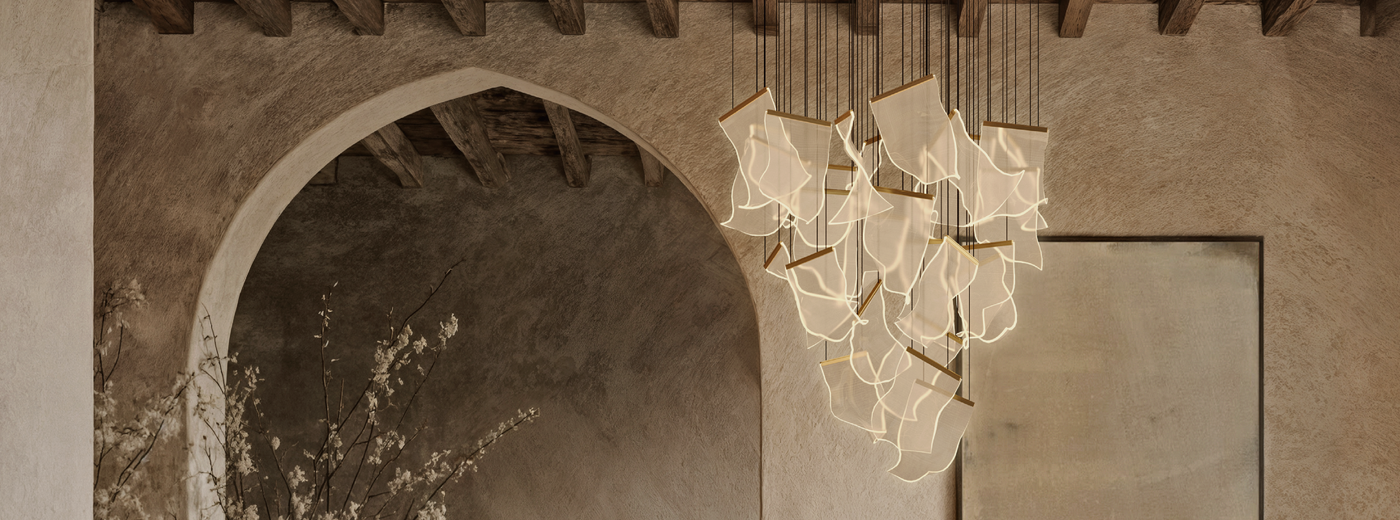Luxury Chandeliers Collection
Handcrafted chandeliers in brass, crystal, and glass—LED‑ready and dimmable for dining rooms, foyers, and living spaces.
- Premium materials: solid brass, artisan‑blown glass, hand‑finished crystal.
- Versatile formats: modern linear chandeliers for tables/islands; tiered crystal chandeliers for grand entries and staircases.
- Ceiling friendly: options for standard, vaulted, and sloped ceilings with adjustable chain/rod lengths.
- Built for control: compatible with dimmer switches to shift from task to ambient lighting.
Why Choose Handcrafted Chandeliers?
We don’t believe in off-the-rack lighting. Every chandelier we offer is designed with intention and built to last. Our collection brings together the warm elegance of brass, the shimmer of crystal accents, and the clean lines of modern design. Whether you're outfitting a dining room, refreshing a bedroom, or finishing off a foyer, you’ll find chandeliers that feel made for your space.
- Made to Elevate: From sleek linear chandeliers built for open-concept kitchens to elegant office chandeliers and layered hallway chandeliers that dramatically define grand entryways, our fittings don’t just light a room. They complete it.
- Lighting for Every Room: We design lighting solutions for every corner of the home, whether it's a classic dining room ceiling light, a compact fitting for your hallway, or bedroom illumination installations that double as decor, plus outdoor chandeliers for covered patios and sophisticated office chandelier options for professional spaces.
- Smart and Stylish: All of our chandeliers support LED bulbs, work with dimmer switches, and pair aesthetics with energy efficiency. Because lighting should work as a bold statement.
- A Style for Every Home: From mid-century to farmhouse chandeliers and everything in between, our range includes timeless, contemporary, rustic and sleek minimalist chandeliers, and luxurious metal chandeliers installations crafted to feel personal and lasting.
Layered Lighting Looks Best
One of the easiest ways to elevate your home’s atmosphere is through layered lighting. Don’t stop at just the chandelier ceiling fixture. Combine your main piece with supporting light sources like pendant lights, wall sconces, or ceiling lights to control shadows, add texture, and create balance.
- A statement chandelier above your dining area, complemented by subtle wall lighting
- Overhead bedroom chandeliers paired with bedside sconces
- A softly glowing hallway chandelier with a warm lamp on a side table nearby. Depending on the length of the table.
- Statement pendant lights flanking a chandelier for balanced illumination
- Coordinating wall sconces with your chandelier finish for design continuity
- Ceiling lights in adjoining rooms to maintain consistent lighting flow
The key to successful layered lighting is ensuring all fixtures work together harmoniously. Consider pairing your chandelier with table lamps for reading nooks or floor lamps in corners to eliminate harsh shadows and create a welcoming atmosphere throughout your space.
Explore Our Complete Chandelier Collection
Chandelier for Every Space: Dining Room Chandeliers | Living Room Chandeliers | Bedroom Chandeliers | Kitchen Chandeliers | Entryway Chandeliers | Staircase Chandeliers | Bathroom Chandeliers
Popular Chandelier Styles: Modern Chandeliers | Traditional Chandeliers | Farmhouse Chandeliers | Rustic Chandeliers | Industrial Chandeliers | Mid Century Chandeliers | Art Deco Chandeliers
Premium Materials: Crystal Chandeliers | Brass Chandeliers | Glass Chandeliers | Wood Chandeliers
Expert Guides: Chandelier Sizing Guide | Installation Guide | Choosing Dining Room Chandeliers | Chandelier Bulb Types | Maintenance & Care
How to Choose the Perfect Chandelier for Every Home
Selection of chandeliers isn’t only about looks. It’s a balance of design, function, and scale.
- Daily or Occasional Use: Some rooms are part of the everyday rhythm—meals, mornings, conversations. Others serve a more occasional purpose, like a formal dining space or guest area. That difference changes what kind of light feels lively.
- What the room needs from the fixture: Not every chandelier needs to be bright. Some rooms feel better with softer light that sits in the background. Others need a stronger presence, something functional that still looks aesthetic.
- Making sure it fits: The variety of sizes for your chandelier matters just as much as the design. It should feel like it belongs—not too small, not overstated. Whether it’s over a table or in a tall entry ceiling, the proportions should feel natural.
- Install a Dimmer Switch: Having dimming or smart features isn’t just a luxury anymore. Being able to shift the lighting depending on the time of day or the way the room is being used adds real value.
Dimmer Compatibility
The majority of our fixtures pair seamlessly with dimmer switches, and we recommend our brass fixtures collection for coordinated electrical accessories.
A Quick Note on Chandelier Installation
Chandelier installation varies greatly depending on fixture complexity and location. Simple minimalist chandeliers or compact bedroom chandeliers under 15 lbs may be manageable for experienced DIY enthusiasts. However, we strongly recommend professional installation for elaborate crystal chandeliers, staircase chandeliers, or multi-tiered traditional chandeliers.
Professional installation ensures proper structural support, electrical safety, code compliance, and optimal positioning. It also protects your investment and maintains warranty coverage for premium fixtures like our brass fixtures collection.
Installation Resources: Complete Installation Guide | Wiring Instructions | Height Guidelines | Weight Specifications
DIY considerations: Do it yourself only if you are experienced working with electrical and the fixture is under 15 lbs.












































